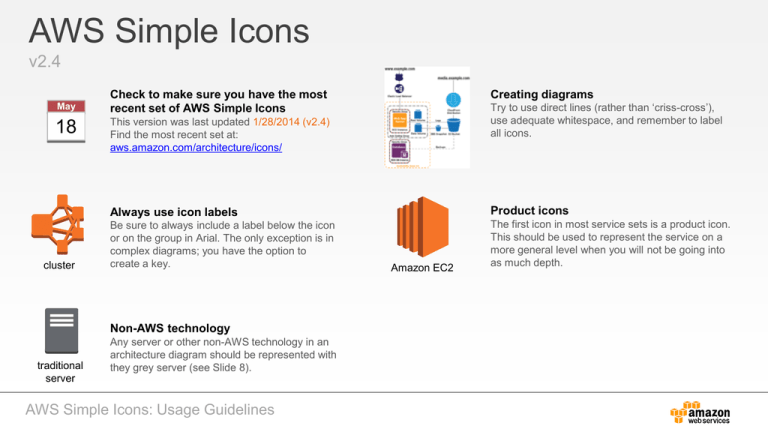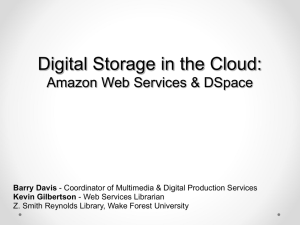AWS Simple Icons - Amazon Web Services
advertisement

AWS Simple Icons v2.4 May 18 cluster Check to make sure you have the most recent set of AWS Simple Icons Try to use direct lines (rather than ‘criss-cross’), use adequate whitespace, and remember to label all icons. This version was last updated 1/28/2014 (v2.4) Find the most recent set at: aws.amazon.com/architecture/icons/ Always use icon labels Product icons Be sure to always include a label below the icon or on the group in Arial. The only exception is in complex diagrams; you have the option to create a key. The first icon in most service sets is a product icon. This should be used to represent the service on a more general level when you will not be going into as much depth. Non-AWS technology traditional server Creating diagrams Any server or other non-AWS technology in an architecture diagram should be represented with they grey server (see Slide 8). AWS Simple Icons: Usage Guidelines Amazon EC2 Compute & Networking Amazon Elastic Compute Cloud Amazon EC2 instance instances AMI DB on instance instance with CloudWatch Elastic IP Amazon Virtual Private Cloud Amazon VPC router Internet gateway customer gateway AWS Simple Icons: Compute & Networking virtual private gateway VPN connection VPC peering optimized instance Amazon Lambda Compute & Networking Amazon Route 53 Amazon Route 53 hosted zone Elastic Load Balancing route table AWS Direct Connect AWS Direct Connect AWS Simple Icons: Compute & Networking Elastic Load Balancing Compute & Networking Auto Scaling Auto Scaling Elastic Network Instance elastic network instance AWS Simple Icons: Compute & Networking Storage & Content Delivery Amazon Simple Storage Service Amazon S3 bucket bucket with objects AWS Import/Export object Amazon Elastic Block Store Amazon EBS volume snapshot AWS Simple Icons: Storage & Content Delivery AWS Import/Export AWS Storage Gateway AWS Storage Gateway non-cached volume cached volume virtual tape library Storage & Content Delivery Amazon Glacier Amazon Glacier archive vault Amazon CloudFront CloudFront download distribution streaming distribution AWS Simple Icons: Storage & Content Delivery edge location Database Amazon DynamoDB DynamoDB table item items attribute attributes global secondary index Amazon Relational Database Service Amazon RDS RDS DB instance RDS DB RDS DB instance standby instance read (Multi-AZ) replica AWS Simple Icons: Database MySQL DB instance Oracle DB instance MS SQL instance Database Amazon Relational Database Service Cont. PostgreSQL instance SQL master SQL slave PIOP Amazon SimpleDB Amazon Redshift Amazon SimpleDB Amazon Redshift solid state disks domain AWS Simple Icons: Database Amazon ElastiCache ElastiCache cache node DW1 Dense Compute DW2 Dense Compute Redis Memcached Enterprise Applications Amazon WorkDocs Amazon WorkDocs new! Amazon WorkSpaces Amazon WorkSpaces Administration & Security AWS Directory Service AWS Directory Service AWS Trusted Advisor AWS Trusted Advisor AWS Config AWS CloudTrail AWS Config AWS CloudTrail Amazon CloudWatch CloudWatch alarm Administration & Security AWS Identity and Access Management IAM long-term security credential IAM add-on temporary security credential AWS Security Token Service MFA token data encryption key encrypted data permissions role Deployment & Management AWS Elastic Beanstalk Elastic Beanstalk application deployment AWS CloudFormation AWS CloudFormation template AWS CodeDeploy stack AWS Simple Icons: Deployment & Management AWS CodeDeploy Deployment & Management AWS OpsWorks AWS OpsWorks resources stack layers permissions AWS Simple Icons: Deployment & Management instances apps deployments monitoring Deployment & Management AWS Identity and Access Management IAM long-term security credential IAM add-on temporary security credential AWS Security Token Service data encryption key MFA token AWS Simple Icons: Deployment & Management encrypted data permissions role Application Services Amazon CloudSearch Amazon Simple Email Service Amazon CloudSearch Amazon SES SDF metadata Amazon AppStream Amazon AppStream AWS Simple Icons: App Services email App Services Amazon Simple Queue Service Amazon SQS queue message Amazon Elastic Transcoder Elastic Transcoder AWS Simple Icons: App Services Amazon Simple Workflow Amazon SWF decider worker Analytics Amazon Elastic MapReduce Amazon EMR cluster Kinesis Amazon Kinesis MapR M3 engine MapR M5 engine MapR M7 engine engine AWS Data Pipeline Kinesis-enabled app AWS Data Pipeline Mobile Services Amazon Cognito Amazon Cognito Amazon Mobile Analytics Amazon Mobile Analytics Amazon Simple Notification Service Amazon SNS email notification HTTP notification topic Non-Service Specific AWS cloud AWS Management Console virtual private cloud forums client mobile client multimedia Internet user traditional server corporate data center disk generic database tape storage AWS Simple Icons: Non-Service Specific users On-Demand Workforce Amazon Mechanical Turk Amazon Mechanical Turk Human Intelligence Tasks (HIT) assignment/ task workers Mechanical Turk vs. Amazon Mechanical Turk Do not use simple "Mechanical Turk" to refer to Amazon Mechanical Turk. Use Amazon Mechanical Turk to describe the entire system, Amazon Mechanical Turk website for the worker website, and Amazon Mechanical Turk web service to describe the product. AWS Simple Icons: On-Demand Workforce Requester SDKs Java iOS JavaScript Android AWS Simple Icons: SDKs Python (boto) AWS Toolkit for Visual Studio PHP .NET AWS Toolkit for Eclipse Ruby AWS Tools for Windows PowerShell Node.js AWS CLI Groups Auto Scaling group Elastic Beanstalk container AWS Simple Icons: Groups Availability Zone EC2 instance contents region security group VPC subnet server contents Groups virtual private cloud AWS Simple Icons: Groups AWS cloud corporate data center Example 1: 2-Tier Auto-scalable Web Application Architecture in 1 AZ www.example.com media.example.com CloudFront distribution Elastic Load Balancing web app server root volume EC2 instance security group data volume Auto Scaling group security group Availability Zone #1 AWS Simple Icons: Example 1 logs Amazon EBS snapshot Amazon S3 bucket








